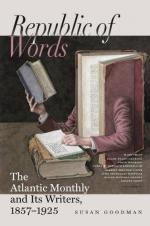But if the quail, who is here very near his northern limits, has a hard time of it in the winter, and is threatened with such “removal” as we treat the Indians to, his relative, the partridge, our other gallinaceous or hen-like bird, is of a tougher fibre, as you see when you come upon his star-like tracks across the path, eight or nine inches apart, and struck sharp and deep in the snow, or closer together among the bushes, where he stretched up for barberries or buds, and ending on either side with a series of fine parallel cuts, where the sharp-pointed quills struck the snow as he rose,—a picture of vigor and success. He knows how to take care of himself, and to find both food and shelter in the evergreens, when the snow lies fresh upon the ground. There, in some sunny glade among the pines, he will ensconce himself in the thickest branches, and whir off as you come near, sailing down the opening with his body balancing from side to side.
The partridge is altogether a wilder and more solitary bird than the quail, and does not frequent cultivated fields, nor make his nest in the orchard, as the quail does, but prefers the shelf of some rocky ledge under the shadow of the pines in remote woods. He is one of the few birds found in the forest; for it is a mistake to suppose that birds abound in the forest, or avoid the neighborhood of man. On the contrary, you may pass days and weeks in our northern woods without seeing more than half a dozen species, of which the partridge is pretty sure to be one. All birds increase in numbers about settlements,—even the crow, though he is a forest bird too. Hence, no doubt, has arisen the notion that the crow (supposed to be of the same species with the European) made his appearance in this country first on the Atlantic coast, and gradually spread westward, passing through the State of New York about the time of the Revolution. I was told some years since by a resident of Chicago, that the quails had increased eight-fold in that vicinity since he came there. The fact is, that the bird population, like the human, in the absence of counteracting causes, will continue to expand in precise ratio to the supply of food. The partridge goes farther north than the quail, and is found throughout the United States. With us he affects high and rocky ground, but northward he keeps at a lower level. At the White Mountains, the regions of this species and of the Canada grouse or spruce partridge are as well defined in height as those of the maples and the “black growth.” Still farther north I have observed that our partridge frequents the lowest marshy ground, thus equalizing his climate in every latitude.




